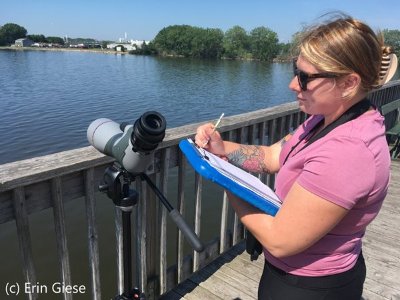Green Bay Cormorants & Pelicans

Since 2021, the Cofrin Center for Biodiversity has been leading an effort to document the importance of piscivorous (fish-eating) birds in lower Green Bay in collaboration with scientists from the U.S. Department of Agriculture, WI Department of Natural Resources, U.S. Fish and Wildlife Service, and Birds Canada. With funding from Wisconsin Sea Grant, Cofrin Center's Dr. Robert Howe, Dr. Amy Wolf, and Erin Giese are leading this project in collaboration with other scientists (Dr. Brian Dorr, Brad Smith, Josh Martinez, and others) and have enlisted several graduate and undergraduate students to assist with field work. Two master's theses will be completed by graduate students Jacob Woulf and Brandon Byrne.



The primary objectives of this project are to 1) evaluate the energetics and spatial dynamics of foraging by large, colonial birds in lower Green Bay, particularly Double-crested Cormorants (Nannopterum auritum) and American White Pelicans (Pelecanus erythrorhynchos); 2) assess how these birds influence fish populations in Green Bay, and 3) provide a foundation for lower Green Bay trophic models that include piscivorous birds. Little is known about the impact of large fish-eating birds on lower Green Bay’s fish community, including economically important walleye, yellow perch (Perca flavescens), and other fisheries, as well as populations of undesirable invasive species like round goby (Neogobius melanostomus). This project will evaluate the numbers, diet, and movements of piscivorous birds within this important ecosystem.


During the summer of 2021, Cofrin Center faculty, staff, and students and biologists from other organizations captured and attached transmitters to 33 Double-crested Cormorants from the Cat Island Restoration Site. They attached CTT GSM transmitters that use the cellular network and solar power for tracking exact movements of individual birds to 12 cormorants. Of the remaining 21 birds, they outfitted cormorants with CTT Power Tags (TM), which emit signals that are detected when within range of radio towers to infer presence of cormorants.
Between April and November, faculty, staff and students conduct piscivorous surveys every other week to estimate bird populations of any fish-eating bird species across the lower bay, including the use of drones. During the summer, students capture foraging behaviors of individual Double-crested Cormorants and American White Pelicans and collect regurgitated pellets, which are dissected in the lab to identify consumed fish of a cormorant or pelican.
In summer 2022, the field team will next attach transmitters to American White Pelicans to document and better understand their seasonal movements. This project will conclude in early 2023 and will produce bird population estimates and foraging patterns of piscivorous birds in lower Green Bay, a detailed diet analysis, distributions of fish prey, and an online story map featuring the background and outcomes of this exciting project.